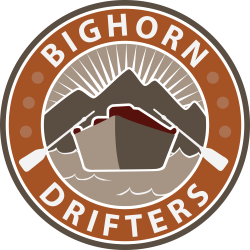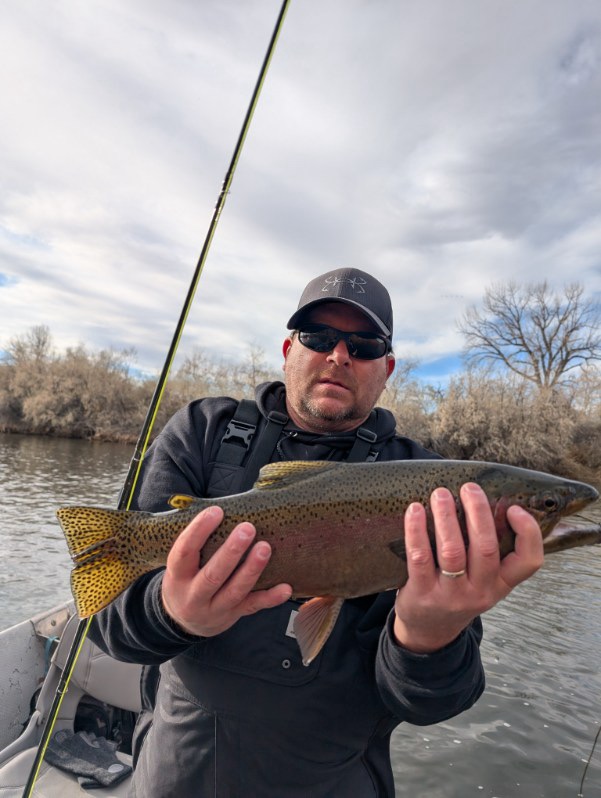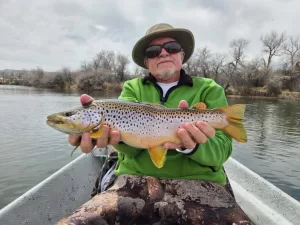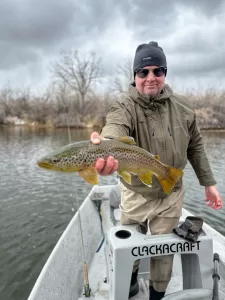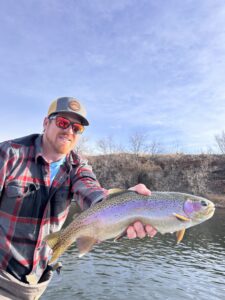Wyoming Bighorn River (Thermopolis Wyoming)
Wedding of the Water downstream
Date and Time: December 26th, 2024
Weather Conditions: Weather Forecast
January in Thermopolis, Wyoming, is one of the coldest months of the year, with average daytime highs ranging from 25°F to 35°F and nighttime lows often dipping into the single digits or below zero. Snowfall is generally light compared to other areas of Wyoming, but the ground often remains snow-covered due to consistently cold temperatures. The clear, crisp winter days are occasionally interrupted by overcast skies and brief snow flurries. Despite the chill, the area’s famous hot springs provide a unique winter attraction, creating pockets of warmth and mist in the otherwise frosty landscape. For anglers, winter fishing opportunities are limited but rewarding, as the cold weather often leads to lower fishing pressure and clear waters.
Water Conditions: Current Flows
Hatches and Insects:
In the winter, the primary insect activity in Thermopolis rivers comes from midges, which are small but vital to the aquatic food web. These tiny insects hatch year-round, making them a consistent food source for trout during the colder months when other insect activity dwindles. Alongside midges, the river ecosystem still supports a variety of other prey items. Minnows, leeches, worms and sow bugs remain active in the cold water, providing a protein-rich meal for opportunistic fish.
Fish Activity and Fishing Tips:
As winter settles in, fish transition into their seasonal holding patterns, favoring slow, deep runs where they can conserve energy in the colder water. These winter runs provide the ideal combination of protection and food availability, making them prime targets for anglers. The tail-outs of fast runs can also produce large fish, as they often linger there to feed before returning to slower waters. During this time of year, fish become less opportunistic and more deliberate in their feeding habits, requiring a precise presentation to entice a strike. Adjusting the weight and depth of your setup is critical, ensuring that your fly drifts naturally and reaches the fish in their preferred holding zones. A slow, methodical approach is key to success in the winter months.
Flies:
Dries: Griffith Gnat, Crystal Midge, Antonio’s Emerger, BWO
Nymphs: Ray Charles, Hot Head Sow, Soft Hackle Sow, Tailwater Sow, Tungsten Surveyor, Manhattan Midge, Poison Tongue, Black Beauty, Zebra Midge, San Juan, Top Secret Midge
Streamers: Goldie, Rusty Trombone, Sparkle Minnow, Lil’Kim
Catches and Success Rates:
Colder temperatures are causing fish to pod up in slower, deeper water, where they conserve energy and remain more sedentary. With less insect activity and fewer active prey options, their food supply becomes more limited during this time of year. However, this scarcity can work in the angler’s favor, as fish are more likely to take advantage of well-presented offerings that mimic the limited forage available. Additionally, reduced fishing pressure means less competition from other anglers, allowing for a quieter and more productive experience on the water. By focusing on precise presentations and understanding the fish’s winter habits, anglers can take full advantage of these unique conditions.
Local Regulations and Updates: 2024 Fishing Regulations
General Fishing Tips:
Be prepared with plenty of warm clothing. We also recommend warm, waterproof boots.
Future Predictions:
If the weather remains consistent, fishing conditions are likely to stay steady over the next few months. Fish will continue to hold in their winter patterns, favoring slow, deep runs with limited movement. The predictable weather will maintain water temperatures and insect activity at stable levels, ensuring a consistent food supply. Anglers can expect similar opportunities, with success depending on precise presentations and adapting to the fish’s slower, deliberate feeding habits.
